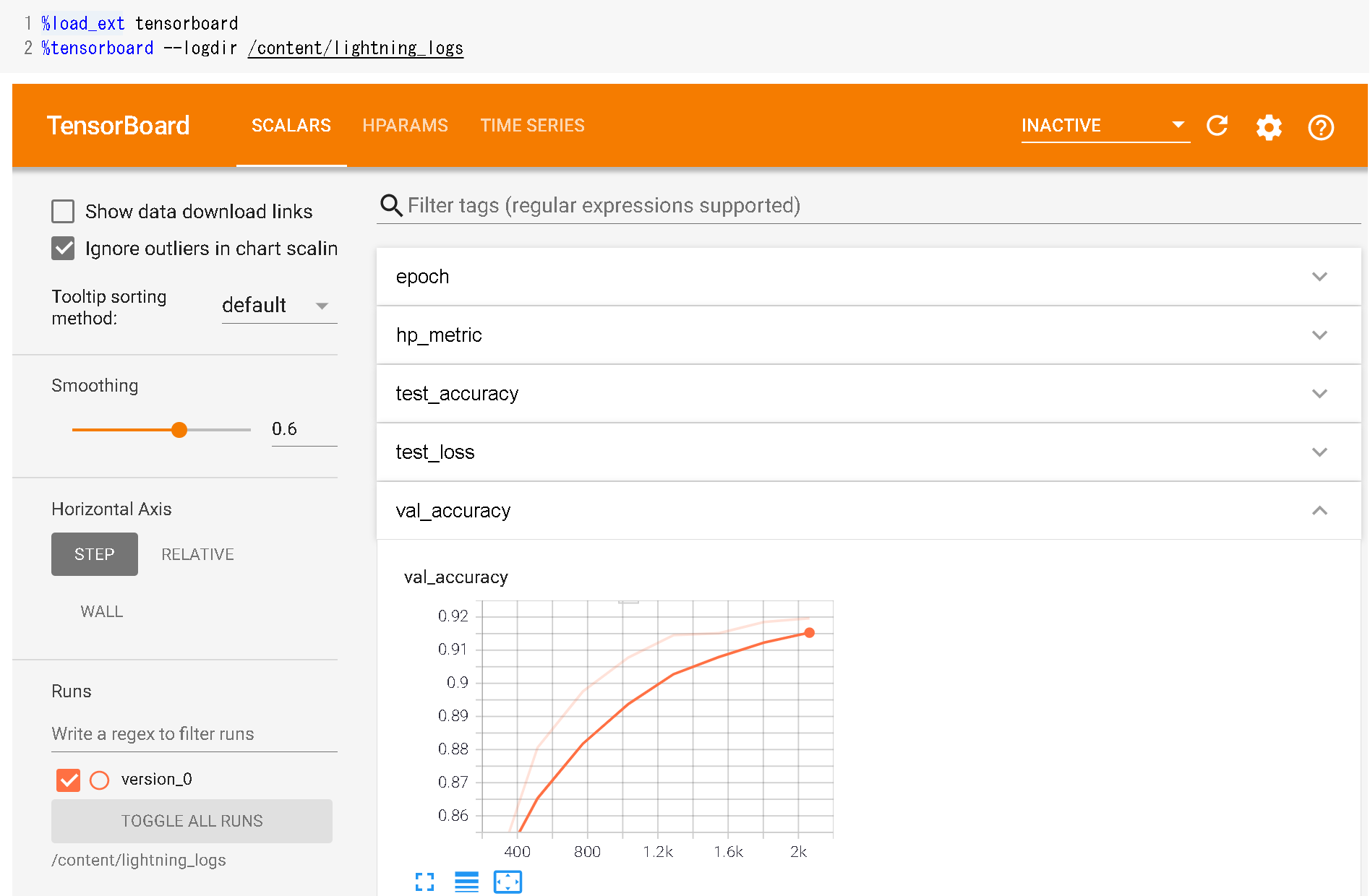はじめに
PytorchでのBERTの分類モデル実装時に、コードの長さと使いまわしのしにくさを感じていたところ、Pytorch Lightningというフレームワークを知ったので実装してみました。
※Pytorch Lightningとは何か?については下記の記事が分かりやすく、参考にさせて頂きました。
[PyTorch 三国志(Ignite・Catalyst・Lightning)]
(https://qiita.com/fam_taro/items/c32e0a21cec5704d9a92)
Google Colaboratoryで実行できるnotebookもgitで公開していますので、よろしければ参考にして頂き、間違っている点などあれば是非ご指摘いただけますと幸いです。
[pytorch_lightning_text_classification.ipynb]
(https://github.com/tchih11/qiita/blob/main/notebooks/pytorch_lightning_text_classification/pytorch_lightning_text_classification.ipynb)
環境
Google Colaboratory
各種インポート
%%capture
!pip install transformers==3.5.1
!pip install fugashi
!pip install ipadic
!pip install pytorch-lightning==1.1.0
import os
import numpy as np
import pandas as pd
import pytorch_lightning as pl
import torch
import torch.optim as optim
from pytorch_lightning.callbacks import EarlyStopping, ModelCheckpoint
from sklearn.model_selection import train_test_split
from torch import nn
from torch.utils.data import DataLoader, Dataset
from transformers import BertModel
from transformers.tokenization_bert_japanese import BertJapaneseTokenizer
モデリング用データセットの前処理
BERTの分類モデルを作成する際には、前処理として文章をtokenizeしてDataLoaderにする必要があります。今回は自作DatasetとLightningDataModuleを継承したクラスを使用して前処理を行い、モデリングできる状態にしていきます。
classの定義
class CreateDataset(Dataset):
"""
DataFrameを下記のitemを保持するDatasetに変換。
text(原文)、input_ids(tokenizeされた文章)、attention_mask、labels(ラベル)
"""
def __init__(self, data, tokenizer, max_token_len):
self.data = data
self.tokenizer = tokenizer
self.max_token_len = max_token_len
def __len__(self):
return len(self.data)
def __getitem__(self, index):
data_row = self.data.iloc[index]
text = data_row[TEXT_COLUMN]
labels = data_row[LABEL_COLUMN]
encoding = self.tokenizer.encode_plus(
text,
add_special_tokens=True,
max_length=self.max_token_len,
padding="max_length",
truncation=True,
return_attention_mask=True,
return_tensors='pt',
)
return dict(
text=text,
input_ids=encoding["input_ids"].flatten(),
attention_mask=encoding["attention_mask"].flatten(),
labels=torch.tensor(labels)
)
class CreateDataModule(pl.LightningDataModule):
"""
DataFrameからモデリング時に使用するDataModuleを作成
"""
def __init__(self, train_df, valid_df, test_df, batch_size=16, max_token_len=512,
pretrained_model='cl-tohoku/bert-base-japanese-char-whole-word-masking'):
super().__init__()
self.train_df = train_df
self.valid_df = valid_df
self.test_df = test_df
self.batch_size = batch_size
self.max_token_len = max_token_len
self.tokenizer = BertJapaneseTokenizer.from_pretrained(pretrained_model)
def setup(self):
self.train_dataset = CreateDataset(self.train_df, self.tokenizer, self.max_token_len)
self.vaild_dataset = CreateDataset(self.valid_df, self.tokenizer, self.max_token_len)
self.test_dataset = CreateDataset(self.test_df, self.tokenizer, self.max_token_len)
def train_dataloader(self):
return DataLoader(self.train_dataset, batch_size=self.batch_size, shuffle=True, num_workers=os.cpu_count())
def val_dataloader(self):
return DataLoader(self.vaild_dataset, batch_size=self.batch_size, num_workers=os.cpu_count())
def test_dataloader(self):
return DataLoader(self.test_dataset, batch_size=self.batch_size, num_workers=os.cpu_count())
使い方
まずは文章とラベルから成るtrain_df、valid_df、test_df(全てDataFrame)を用意します。今回はcriterionにnn.CrossEntropyLossを使用するので、ラベルは数値型に変換しておきます。
# こんな感じ(データはlivedoorのニュースコーパス)
train_df.head(3)
# > text category
# > 0 スティーブン・... 1
# > 1 10月末、K-1イ ... 0
># 2 今日は大みそか... 6
あとはDataFrameをCreateDataModuleに渡してsetup()すれば完成です。
# 用意したDataFrameの文章、ラベルのカラム名
TEXT_COLUMN = "text"
LABEL_COLUMN = "category"
# 作ったDataFrameを渡してsetup
data_module = CreateDataModule(train_df,valid_df,test_df)
data_module.setup()
setup後のdata_moduleの中身は下記のような形になっています。
# datasetへのアクセス
item = data_module.train_dataset[0]
print(item["input_ids"])
# > tensor([ 2, 27, 26, 26, 70, 25, 6, 120, 356, 186, 337, 7,
# > 1266, 307, 163, 239, 181, 6, 93, 40, 123, 29, 14, 16,
# > ・・・
# > 2690, 23, 19, 322, 197, 11, 1266, 87, 550, 181, 6, 466,
# > 1823, 577, 693, 11, 142, 125, 47, 3])
print(item["input_ids"].shape)
# > torch.Size([512])
# dataloaderのバッチの中身を確認
batch = next(iter(data_module.train_dataloader()))
print(batch["input_ids"])
# > tensor([[ 2, 55, 28, ..., 18, 19, 3],
# > [ 2, 569, 67, ..., 145, 427, 3],
# > ...,
# > [ 2, 45, 49, ..., 163, 1143, 3],
# > [ 2, 672, 11, ..., 8, 451, 3]])
print(batch["input_ids"].shape)
# > torch.Size([16, 512])
# → batch_size × max_token_lenになっている
モデリングの実行 & 精度検証
クラスの定義
データの準備が整ったら、LightningModuleを継承してモデリング用クラスを作成します。
def xx_stepで、training/validation/testの各フェーズごとにミニバッチの処理を定義することができる点が特徴です。関数名をフックにして各フェーズで必要となる処理、例えばtraining時のmodel.train()やloss.backward()、validation時のmodel.valid()やtorch.no_grad()といった処理は内部的に行ってくれるため、記述は不要です。全フェーズで必要な.to(device)などの処理も内部的にやってくれます。
__init__、forwardを定義するところは普通にpytorchで実装する場合とほぼ変わりません。
class TextClassifier(pl.LightningModule):
def __init__(self, n_classes: int, n_epochs=None,
pretrained_model='cl-tohoku/bert-base-japanese-char-whole-word-masking'):
super().__init__()
# モデルの構造
self.bert = BertModel.from_pretrained(
pretrained_model, return_dict=True)
self.classifier = nn.Linear(self.bert.config.hidden_size, n_classes)
self.n_epochs = n_epochs
self.criterion = nn.CrossEntropyLoss()
# BertLayerモジュールの最後を勾配計算ありに変更
for param in self.bert.parameters():
param.requires_grad = False
for param in self.bert.encoder.layer[-1].parameters():
param.requires_grad = True
# 順伝搬
def forward(self, input_ids, attention_mask, labels=None):
output = self.bert(input_ids, attention_mask=attention_mask)
preds = self.classifier(output.pooler_output)
loss = 0
if labels is not None:
loss = self.criterion(preds, labels)
return loss, preds
# trainのミニバッチに対して行う処理
def training_step(self, batch, batch_idx):
loss, preds = self.forward(input_ids=batch["input_ids"],
attention_mask=batch["attention_mask"],
labels=batch["labels"])
return {'loss': loss,
'batch_preds': preds,
'batch_labels': batch["labels"]}
# validation、testでもtrain_stepと同じ処理を行う
def validation_step(self, batch, batch_idx):
loss, preds = self.forward(input_ids=batch["input_ids"],
attention_mask=batch["attention_mask"],
labels=batch["labels"])
return {'loss': loss,
'batch_preds': preds,
'batch_labels': batch["labels"]}
def test_step(self, batch, batch_idx):
loss, preds = self.forward(input_ids=batch["input_ids"],
attention_mask=batch["attention_mask"],
labels=batch["labels"])
return {'loss': loss,
'batch_preds': preds,
'batch_labels': batch["labels"]}
# epoch終了時にvalidationのlossとaccuracyを記録
def validation_epoch_end(self, outputs, mode="val"):
# loss計算
epoch_preds = torch.cat([x['batch_preds'] for x in outputs])
epoch_labels = torch.cat([x['batch_labels'] for x in outputs])
epoch_loss = self.criterion(epoch_preds, epoch_labels)
self.log(f"{mode}_loss", epoch_loss, logger=True)
# accuracy計算
num_correct = (epoch_preds.argmax(dim=1) == epoch_labels).sum().item()
epoch_accuracy = num_correct / len(epoch_labels)
self.log(f"{mode}_accuracy", epoch_accuracy, logger=True)
# testデータのlossとaccuracyを算出(validationの使いまわし)
def test_epoch_end(self, outputs):
return self.validation_epoch_end(outputs, "test")
# optimizerの設定
def configure_optimizers(self):
# pretrainされているbert最終層のlrは小さめ、pretrainされていない分類層のlrは大きめに設定
optimizer = optim.Adam([
{'params': self.bert.encoder.layer[-1].parameters(), 'lr': 5e-5},
{'params': self.classifier.parameters(), 'lr': 1e-4}
])
return [optimizer]
使い方
インスタンスの作成、及び各種設定
クラスを使用してインスタンスを作成したら、EarlyStoppingとモデルの保存先の設定を行います。
# epoch数
N_EPOCHS = 10
# モデルインスタンスを作成
model = TextClassifier(n_classes=9,n_epochs=N_EPOCHS)
# EarlyStoppingの設定
# 3epochで'val_loss'が0.05以上減少しなければ学習をストップ
early_stop_callback = EarlyStopping(
monitor='val_loss',
min_delta=0.05,
patience=3,
mode='min')
# モデルの保存先
# epoch数に応じて、「epoch=0.ckpt」のような形で指定したディレクトリに保存される
checkpoint_callback = ModelCheckpoint(
dirpath="./checkpoints",
filename='{epoch}',
verbose=True,
monitor='val_loss',
mode='min'
)
# Trainerに設定
trainer = pl.Trainer(max_epochs=N_EPOCHS,
gpus=1,
progress_bar_refresh_rate=30,
callbacks=[checkpoint_callback, early_stop_callback])
学習の実行
設定が終わったらいよいよ学習です。勝手にループしてくれるので、for文の記述は不要です。
# 学習
trainer.fit(model, data_module)
テストの実行
一番lossが少なかった時点のモデルを使用してtestデータへの当てはめを行います。
# テスト
result = trainer.test(ckpt_path=checkpoint_callback.best_model_path)
# > -----------------------------------------------------------
# > DATALOADER:0 TEST RESULTS
# > {'test_accuracy': 0.9170632222977566,
# > 'test_loss': tensor(0.2891, device='cuda:0'),
# > 'val_accuracy': 0.9196378041878891, ← この数値は最後のvalidation epochの結果(≠ 最良モデル)
# > 'val_loss': tensor(0.3031, device='cuda:0')}
# > -----------------------------------------------------------
TensorBoard
モデリング用クラス作成時にself.log()で定義した数値はTensorBoardでも確認可能です。
# Google Colaboratoryの場合
%load_ext tensorboard
%tensorboard --logdir /content/lightning_logs

checkpointからのモデルをロード
下記のような形で、checkpointを指定してモデルをロードすることも可能です。
# 指定したcheckpointのモデルをロード
trained_model = TextClassifier.load_from_checkpoint('./checkpoints/epoch=0.ckpt',n_classes=9)
感想
普通に実装するよりは格段にスッキリするし、使いまわしもしやすくなったと感じます。また、Early Stoppingなどを手軽に実装できるのも嬉しいですね。まだまだ未開拓な部分もたくさんあるので、徐々に開拓していきたいです。
参考
- 公式ドキュメント
[PYTORCH LIGHTNING DOCUMENTATION]
(https://pytorch-lightning.readthedocs.io/en/latest/) - Pytorch Lightningとは何か的なところ
[PyTorch 三国志(Ignite・Catalyst・Lightning)]
(https://qiita.com/fam_taro/items/c32e0a21cec5704d9a92) - 実装(記事)
[【実装解説】日本語版BERTでlivedoorニュース分類:Google Colaboratoryで(PyTorch)]
(https://qiita.com/sugulu_Ogawa_ISID/items/697bd03499c1de9cf082)
[速習 pytorch-lightning: 今すぐ機械学習の実験をしたいそこのキミへ]
(https://qiita.com/yamad07/items/d08098544ea5db9c9674)
[日本語BERTモデルをPyTorch用に変換してfine-tuningする with torchtext & pytorch-lightning]
(https://radiology-nlp.hatenablog.com/entry/2020/01/18/013039) - 実装(youtube動画、全部英語)
[PyTorch Lightning MasterClass]
(https://www.youtube.com/playlist?list=PLaMu-SDt_RB5NUm67hU2pdE75j6KaIOv2)←公式、再生リスト
[Fine-Tuning BERT with HuggingFace and PyTorch Lightning for Multilabel Text Classification | Dataset]
(https://www.youtube.com/watch?v=wG2J_MJEjSQ)
[Fine-Tuning BERT with HuggingFace and PyTorch Lightning for Multilabel Text Classification | Train]
(https://www.youtube.com/watch?v=UJGxCsZgalA&t=2777s)
